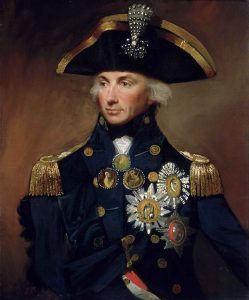
By Robert Croan
Haydn’s six late-in-life settings of the Catholic Mass are outpourings of joy, reflecting the composer’s optimism and attitude towards life – even when, as in 1798, he labeled his Mass in D minor, “Mass in Troubled Times.”
The “trouble” was Napoleon’s invasion of Egypt, designed to interfere with his enemies’ trade routes, directly or indirectly threatening the very existence of the Austro-Hungarian empire. Admiral Horatio Nelson became an international hero that year, by defeating Napoleon in the Battle of the Nile. When Nelson visited Esterhazy Palace two years later, Haydn, as court composer, revived his D minor Mass — now popularly known as the “Lord Nelson” Mass — in a splendid concert that Miami-based vocal ensemble Seraphic Fire duplicated last weekend to close its annual Enlightenment Festival (seen Feb. 24 in Fort Lauderdale’s All Saints Episcopal Church).
The Mass was the main part of the program, vividly brought to life by a 20-voice choir — the Seraphic singers augmented with students from UCLA’s Herb Alpert School of Music — along with a first-rate orchestra of equal size, conducted by Seraphic’s artistic director Patrick Dupré Quigley.
Its opening Kyrie set the mood and tone: serious but uplifting, the first pronouncement dominated by the trumpets and timpani, the sacred text enhanced by the soprano soloist’s soaring coloratura (rendered with accuracy and dramatic thrust by Chelsea Helm, although she ducked an intricate staccato run near the beginning). The choral statement of the Gloria was crisp and clearly enunciated, thereafter set into sharp relief by the Quoniam — a segment that became a special highlight as delivered by resonant bass-baritone Jonathan Woody, the most impressive and vocally resplendent among the evening’s soloists. The choral fugato on Quoniam/Cum sancto spiritu that closes this movement was particularly admirable for its lucidity of line and intonation.
Quigley sustained these qualities in the central Credo movement, aptly contrasting choral and solo textures — once more affording opportunities for the fleet-voiced Helm to show off, in these measures, spinning congenial threads of legato. Particularly praiseworthy, later on, was the choral articulation and varied shaping of the recurring Osanna phrases. Alto Clara Ostrowski and tenor James Reese also deserve mention for their briefer solo turns.
Haydn’s Te Deum in C major, which opened the concert, is a lesser work than the Mass, composed at the behest of the empress Marie Therese, who wanted a sacred piece written specifically for herself rather than for her husband. In three sections, with no solo passages, it’s pleasant listening, without as much of the composer’s individual imprint than his A-level output. The rendition was enthusiastic but from time to time tentative, with balance problems (the brasses overwhelming the singers and obscuring the text).
On the occasion that Admiral Nelson visited Esterhazy Palace, he brought with him his mistress, Lady Emma Hamilton, who was married to the British envoy to Naples, but carrying Nelson’s child. Lady Hamilton was herself an accomplished singer, and for the concert, Haydn composed a recitative and aria celebrating Nelson’s Egyptian conquest, Lines from the Battle of the Nile. Performed in-between the two choral works, this cantata-like piece came through as an interesting oddity, in which the story of the battle is told in an elaborate recitative, acclaim for the hero expounded in the aria itself.
The soloist was Nola Richardson, enunciating the words clearly with a bright soprano sound, though more variety of vocal color and nuance would have been welcome in the recitatives, where the story of the battle is narrated in some detail. Richardson turned the melodic phrases quite beautifully in the aria itself, conveying the more generalized proclamation of praise with jubilant éclat and right-on intonation.
The singer was accompanied on the harpsichord with flair and imagination by Leon Schelhase, a superb and valuable keyboard artist who also played a small organ in the two bigger pieces with orchestra.